Page 169 of 358
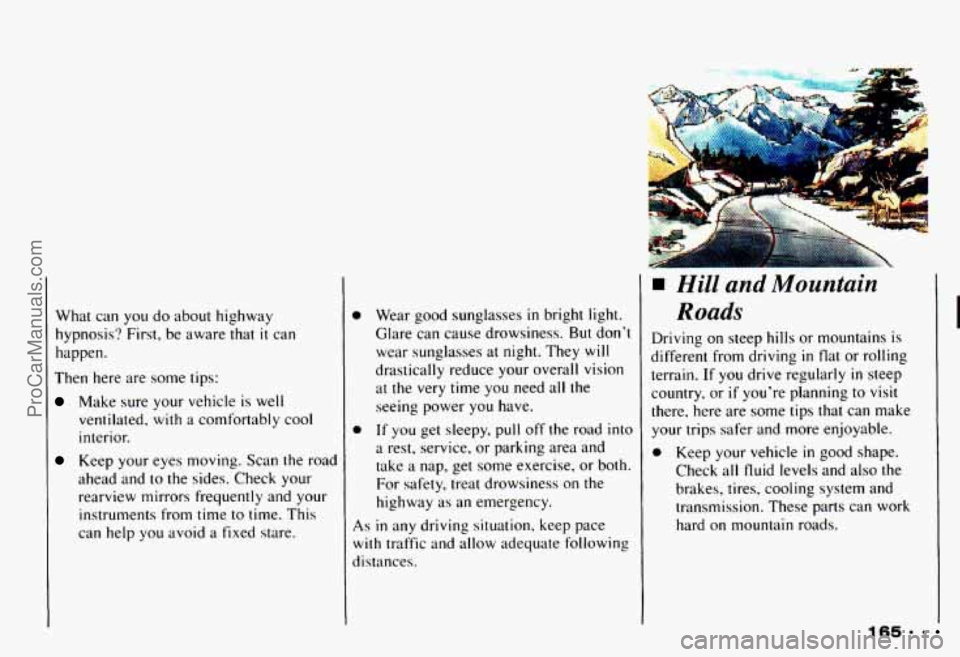
What can you do about highway
hypnosis'? First, be aware that
it can
happen.
Then here are some tips:
Make sure your vehicle is well
ventilated,
with a comfortably cool
interior.
Keep your eyes moving. Scan the road
ahead and
to the sides. Check your
rearview mirrors frequently and your
instruments from time
to time. This
can help you avoid a fixed stare. Wear
good sunglasses
in bright light.
Glare can cause drowsiness.
But don't
wear sunglasses
at night. They will
drastically reduce your overall vision
at
the very time you need all the
seeing power you have.
If you get sleepy,
pull off the road into
a rest, service, or parking area and
take a nap, get some exercise, or both.
For safety, treat drowsiness on the
highway as an emergency.
As in any driving situation. keep pace
with traffic and allow adequate following
distances.
Hill and Mountain
Roads
Driving on steep hills or mountains is
different from driving
in flat or rolling
terrain. If you drive regularly
in steep
country. or
if you're planning to visit
there, here are some tips that can make
your trips safer and more enjoyable.
0 Keep your vehicle in good shape.
Check all fluid levels and also the
brakes, tires, cooling system and
transmission. These parts can work
hard on mountain roads.
1659 *
ProCarManuals.com
Page 170 of 358
Your Driving and the Road
Know how to go down hills. The most
important
thing to know is this: let
your engine
do some of the slowing
down.
Don’t make your brakes do it
all. Shift to a lower gear when you go
down a steep or long hill. That way,
you
will slow down without excessive
use of your brakes.
If you don’t shift down, your
brakes could get
so hot that
they wouldn’t work well. You
would then have poor braking or
even none
going down a hill. You
could crash. Shift down to let your
engine assist your brakes on
a steep
downhill slope.
2 Coasting downhill in
, N (Neutral) or with the ignition
off is dangerous, Your brakes will
have to do all the work of slowing
down, They could get so hot that
they wouldn’t work weiL You could
crash. Always have your engine
running and your vehicle in gear
when you go downhill.
.. 166
ProCarManuals.com
Page 172 of 358
Your Driving and the Road
Parking on Hills
Hills and mountains mean spectacular
scenery.
But please be careful where you
stop
if you decide to look at the view or
take pictures. Look for pull-offs or
parking areas provided for scenic
viewing.
Another part
of this manual tells how to
use your parking brake (see "Parking
Brake"
in the Index). But on a mountain
or steep
hill, you can do one more thing.
You can
turn your front wheels to keep
your vehicle from rolling downhill or out
into traffic.
Here's how:
Parking Downhill
Turn your wheels to the right.
You don't have to jam
your tires against
the curb,
if there is a curb. A gentle
contact
is all you need.
-m
Parking Uphill
If there is a curb, turn your wheels to the
left
if the curb is at the right side of your
vehicle.
ProCarManuals.com
Page 173 of 358
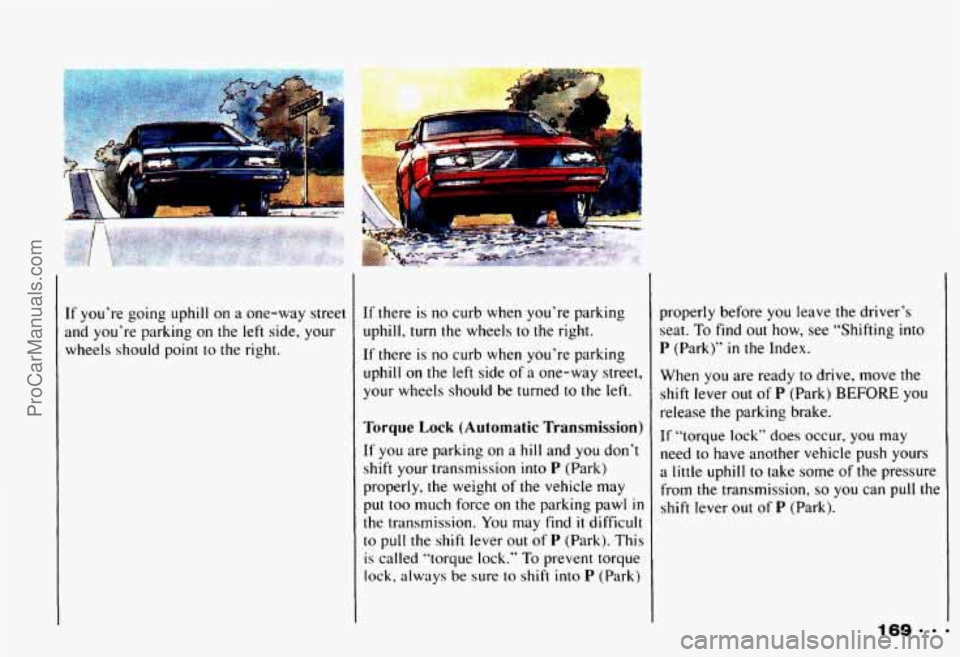
If you’re going uphill on a one-way street
and you’re parking on the left side, your wheels should point to the right. If there is no curb when you’re parking
uphill, turn the wheels
to the right.
If there is no curb when you’re parking
uphill on the left side of a one-way street,
your wheels should be turned to the left.
Torque Lock (Automatic Transmission)
If you are parking on a hill and you don’t
shift your transmission into
P (Park)
properly, the weight
of the vehicle may
put
too much force on the parking pawl in
the transmission. You may find it difficult
to pull the
shift lever out of P (Park). This
is called “torque lock.” To prevent torque
lock, always
be sure to shift into P (Park) properly before
you leave the driver’s
seat.
To find out how, see “Shifting into
P (Park)” in the Index.
When you are ready to drive, move the
shift lever out of
P (Park) BEFORE you
release the parking brake.
If “torque lock” does occur, you may
need to have another vehicle push yours
a little uphill to take some of the pressure
from the transmission,
so you can pull the
shift lever out of
P (Park).
ProCarManuals.com
Page 175 of 358
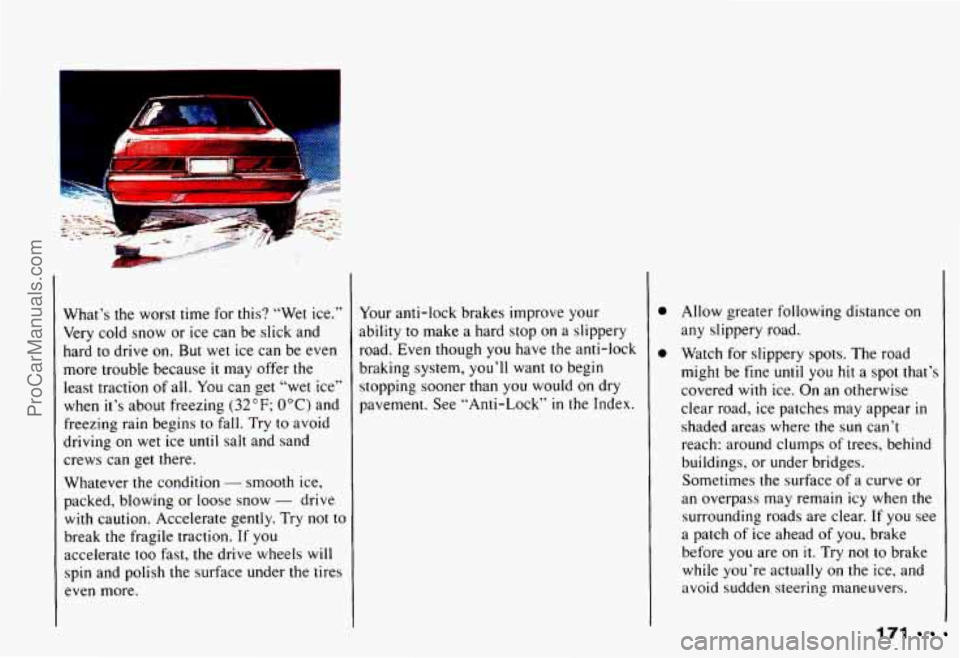
What’s the worst time for this? “Wet ice.”
Very cold snow or ice can be slick and
hard
to drive on. But wet ice can be even
more trouble because
it may offer the
least traction
of all. You can get “wet ice”
when it’s about freezing
(32°F; OOC) and
freezing
rain begins to fall. Try to avoid
driving on wet ice
until salt and sand
crews can get there.
Whatever
the condition - smooth ice,
packed, blowing or loose snow
- drive
with caution. Accelerate gently. Try not to
break the fragile traction. If you
accelerate
too fast, the drive wheels will
spin and polish the surface under the tires
even more. Your
anti-lock brakes improve your
ability
to make a hard stop on a slippery
road. Even though you have the anti-lock
braking system, you’ll want to begin
stopping sooner than you would on
dry
pavement. See “Anti-Lock” in the Index.
0
0
Allow greater following distance on
any slippery road.
Watch for slippery spots. The road
might be fine
until you hit a spot that’s
covered
with ice. On an otherwise
clear road, ice patches
may appear in
shaded areas where the sun can’t
reach: around clumps of trees, behind
buildings, or under bridges.
Sometimes
the surface of a curve or
an overpass may remain icy when the
surrounding roads are clear.
If you see
a patch of ice ahead of you, brake
before you are on
it. Try not to brake
while you’re actually on the ice, and
avoid sudden steering maneuvers.
171
ProCarManuals.com
Page 177 of 358

Run your engine only as long as you
must. This saves fuel. When you
run the
engine, make
it go a little faster than just
idle. That is, push the accelerator slightly.
This uses less fuel for the heat that you
get and
it keeps the battery charged. You
will need a well-charged battery to restart
the vehicle, and possibly for signaling
later on
with your headlights. Let the
heater
run for awhile.
Then. shut the engine off and close the
window almost all the way to preserve the
heat. Start the engine again and repeat this
only when you feel really uncomfortable
from the cold.
But do it as little as
possible. Preserve the fuel as long as you
can.
To help keep warm. you can get out
3f the vehicle and do some fairly vigorous
zxercises every half hour or
so until help
Zomes.
If You're Stuck in Deep Snow
This manual explains how to get the
vehicle
out of deep snow without
damaging it. See "Rocking Your Vehicle"
in the Index.
Towing a Trailer
you can lose control when you pull
a trailer. For example, if the trailer is
too heavy, the brakes may not work
well - or even at all. You and your
passengers could be seriously
injured. Pull a trailer only if you
have followed all the steps in this
section.
ProCarManuals.com
Page 181 of 358
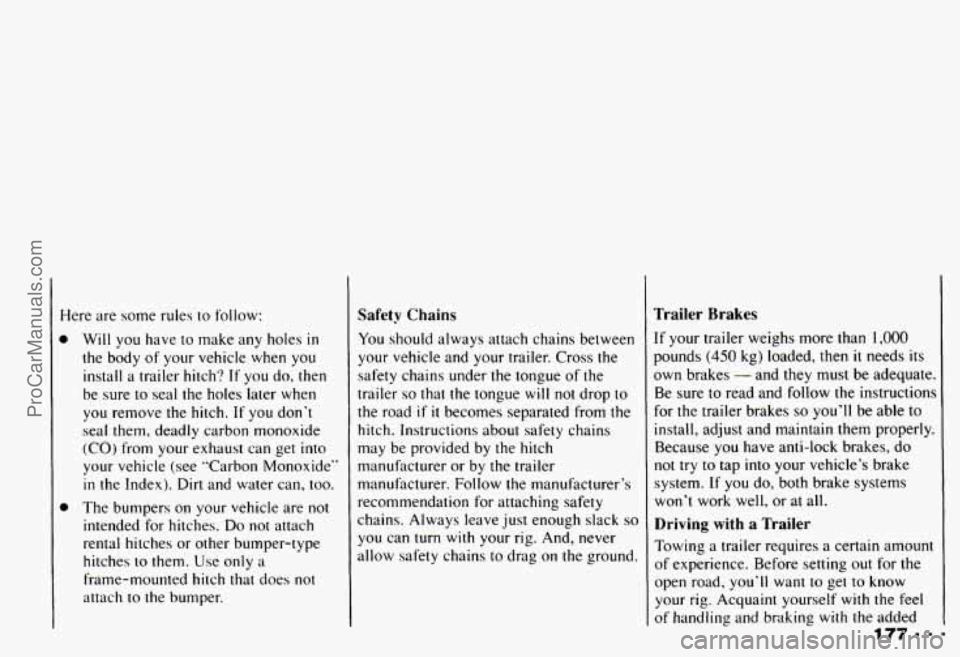
Here are some rules to follow:
0
Will you have to make any holes in
the body of your vehicle when you
install a trailer hitch?
If you do, then
be sure to seal the holes later when
you remove the
hitch. If you don't
seal them, deadly carbon monoxide
(CO) from your exhaust can get into
your vehicle (see "Carbon Monoxide"
in the Index). Dirt and water can, too.
The bumpers on your vehicle are not
intended for hitches.
Do not attach
rental hitches or other bumper-type
hitches
to them. Use only a
frame-mounted hitch that does not
attach
to the bumper.
Safety Chains
You should always attach chains between
your vehicle and your trailer. Cross the
safety chains under the tongue
of the
trailer
so that the tongue will not drop to
the road
if it becomes separated from the
hitch. Instructions about safety chains
may be provided by the hitch
manufacturer or by the trailer
manufacturer. Follow the manufacturer's
recommendation for attaching safety
chains. Always leave just enough slack
so
you can turn with your rig. And, never
a Jlow safety chains to drag on the ground.
Trailer Brakes
If your trailer weighs more than 1,000
pounds (450 kg) loaded, then it needs its
own brakes
- and they must be adequate.
Be sure
to read and follow the instructions
for the trailer brakes
so you'll be able to
install, adjust and maintain them properly.
Because you have anti-lock brakes, do
not
try to tap into your vehicle's brake
system. If you
do, both brake systems
won't
work well, or at all.
Driving with a Trailer
Towing a trailer requires a certain amount
of experience. Before setting out for the
open road, you'll want to get to know
your rig. Acquaint yourself
with the feel
of handling and braking with the added
ProCarManuals.com
Page 182 of 358
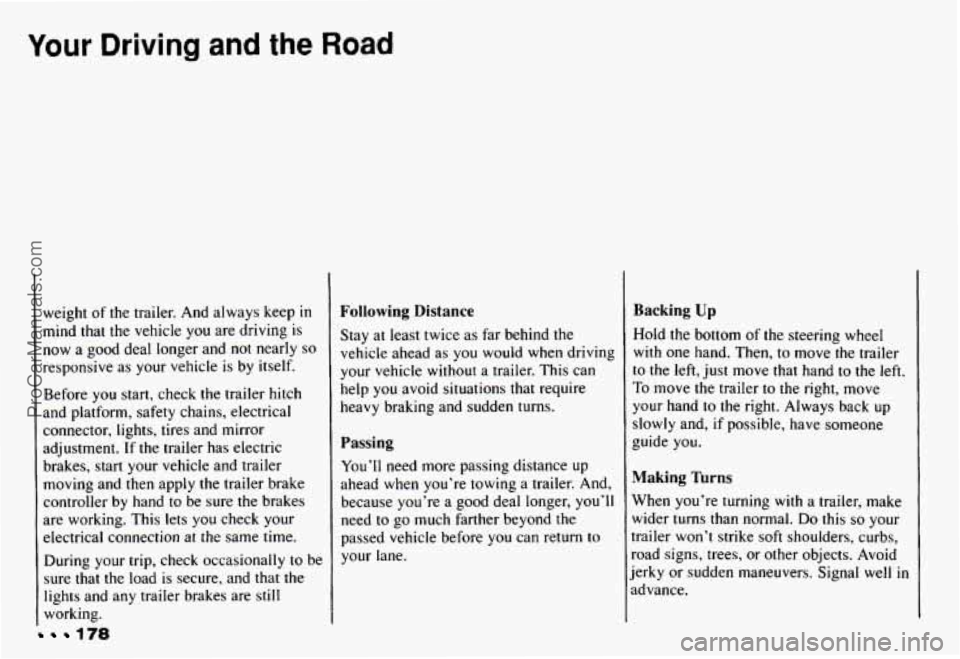
Your Driving and the Road
178
weight of the trailer. And always keep in
mind that the vehicle you are driving is
now a good deal longer and not nearly so
responsive as your vehicle is by itself,
Before you start, check the trailer hitch
and platform, safety chains, electrical
connector, lights, tires and mirror
adjustment. If the trailer has electric
brakes, start your vehicle and trailer
moving and then apply the trailer brake
controller by hand
to be sure the brakes
are working. This lets you check your
electrical connection
at the same time.
During your trip, check occasionally to be
sure that the load is secure, and that the
lights and any trailer brakes are still
working.
Following Distance
Stay at least twice as far behind the
vehicle ahead as you would when driving
your vehicle without a trailer. This can
help you avoid situations that require
heavy braking and sudden turns.
Passing
You’ll need more passing distance up
ahead when you’re towing a trailer. And,
because you’re a good deal longer, you’ll
need to go much farther beyond the
passed vehicle before you can return
to
your lane.
Backing Up
Hold the bottom of the steering wheel
with one hand. Then, to move the trailer
to the left, just move that hand
to the left.
To move the trailer to the right, move
your hand
to the right. Always back up
slowly and,
if possible, have someone
guide you.
Making Turns
When you’re turning with a trailer, make
wider turns than normal.
Do this so your
trailer won’t strike
soft shoulders, curbs,
road signs, trees, or other objects. Avoid
jerky or sudden maneuvers. Signal well
in
advance.
ProCarManuals.com